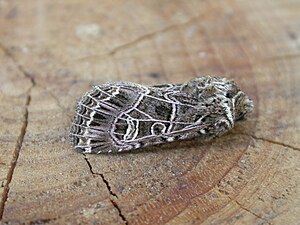Network owl
| Network owl | ||||||||||||
|---|---|---|---|---|---|---|---|---|---|---|---|---|

Reticulated Owl ( Sideridis reticulata ) |
||||||||||||
| Systematics | ||||||||||||
|
||||||||||||
| Scientific name | ||||||||||||
| Sideridis reticulata | ||||||||||||
| ( Goeze , 1781) |
The net owl ( Sideridis reticulata ), also called Haldenflur carnation owl , is a butterfly ( moth ) from the family of the owl butterflies (Noctuidae).
features
butterfly
The wingspan of the moth is 35 to 40 millimeters. The forewings are dark brown to purple-brown in color and covered with a reticulated, whitish pattern. The white veins stand out equally strikingly from the basic color, as do the double transverse lines. Kidney and ring flaws are outlined in light. The black-brown cone blemishes stand out clearly. A few long, dark arrow spots can be seen in the border area. The hind wings are tinted gray-brown without drawing.
Caterpillar, pupa
Adult caterpillars vary in color from brownish to ocher yellow to greenish and are provided with small black dots. In some specimens a whitish side stripe can be seen. The doll is shiny red-brown in color and has a long pointed thorn on the cone-shaped cremaster .
Similar species
From the closely related and very similar species Sideridis kitti and Sideridis unicolor , the net owl can only be distinguished with absolute certainty through genital morphological studies. The letterpress owl ( Naenia typica ), which is also comparable in terms of drawings, has significantly wider wings.
Geographical distribution and habitat
The species is widespread from the Iberian Peninsula across Europe and the temperate zones to East Asia. In the north it occurs in Fennoscandinavia south of the Arctic Circle and in the south through the Mediterranean area to the Middle East . In the Alps it rises to over 2000 meters. The net owl can be found in many habitats, including on warm slopes, on pastures as well as on the edges of forests and in gardens.
Way of life
The moths are nocturnal, like to suckle on various flowers, such as adder's head ( Echium ) or soapwort species ( Saponaria ) and also appear near artificial light sources and also like bait . The moths fly in one generation from May to August. The caterpillars mainly use the fruit capsules of their forage plants as food. These include catchwort ( Silene ) and soapwort species ( Saponaria ). The caterpillars live from July to September and pupate in a burrow to overwinter.
Danger
In Germany the net owl is widespread and can be found in large numbers in certain areas, so that it is classified as not endangered on the Red List of Endangered Species .
swell
Individual evidence
- ↑ Hermann Hacker, László Ronkay, Márton Hreblay: Hadeninae I . In: Michael Fibiger, David Agassiz, Martin Honey (Eds.): Noctuidae Europaeae . tape 4 . Entomological Press, Sorø 2002, ISBN 87-89430-07-7 (English).
- ^ Günter Ebert (Ed.): The butterflies of Baden-Württemberg . 1st edition. tape 7 . Moth V Noctuidae 3rd part. Ulmer, Stuttgart (Hohenheim) 1998, ISBN 3-8001-3500-0 .
- ↑ Walter Forster , Theodor A. Wohlfahrt : The butterflies of Central Europe. Volume 4: Owls. (Noctuidae). Franckh'sche Verlagshandlung, Stuttgart 1971, ISBN 3-440-03752-5 .
- ↑ Federal Agency for Nature Conservation (Ed.): Red List of Endangered Animals in Germany . Landwirtschaftsverlag, Münster 1998, ISBN 3-89624-110-9 .
literature
- Günter Ebert (Ed.): The butterflies of Baden-Württemberg . 1st edition. tape 7 . Moth V Noctuidae 3rd part. Ulmer, Stuttgart (Hohenheim) 1998, ISBN 3-8001-3500-0 .
- Hermann Hacker, László Ronkay, Márton Hreblay: Hadeninae I . In: Michael Fibiger, David Agassiz, Martin Honey (Eds.): Noctuidae Europaeae . tape 4 . Entomological Press, Sorø 2002, ISBN 87-89430-07-7 (English).
Web links
- European Butterflies and Moths by Chris Jonko
- Lepiforum e. V. Photos
- www.schmetterlinge-deutschlands.de Endangerment
- Sideridis reticulata in Fauna Europaea